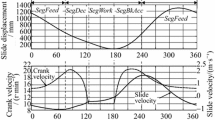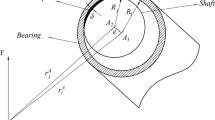Abstract
This study proposes a new, large-scale, eight-link mechanical press that consist of four single degree-of-freedom (DOF) planar eight-link mechanisms and has a carrying capacity of 2000 tons. Kinematic analysis of a single DOF planar eight-link mechanism is presented. On the basis of kinematic analysis and the required output displacement curve, a single DOF planar eight-link mechanism is synthesized using differential evolution algorithm. We propose the use of an improved minimum sum of displacement variance (MSDV) cost function to minimize the influence of processing error on the same positions of different single DOF planar eight-link mechanisms. The improved MSDV cost function enables the setting of different weights for different stages with one stroke depending on the importance of each stage. Simulation results show that the designed mechanical press is consistent with the requirements, and that the improved MSDV cost function effectively reduces the influence of machining error.
Similar content being viewed by others
References
H.-W. Wagener, New developments in sheet metal forming: Sheet materials, tools and machinery, J. Mater. Process. Technol., 72 (1997) 342–357.
R. Du and W. Z. Guo, the design of a new metal forming press with controllable mechanism, Transactions Journal of Mechanical Design., 125 (2003) 582–592.
D. He. Special presses, China Machine Press. Beijing, China (1989).
L. C. Tokuz and J. R. Jones, Programmable modulation of motion using hybrid machine, Proceeding of Imeche, 414/071 (1991) 85–92.
L. C. Tokuz, Hybrid machine modeling and control, Ph.D. Thesis, Department of Mech., Liverpool Polytechnic, UK (1992).
L. C. Tokuz and J. R. Jones, Power transmission and flow in the hybrid machines, The 6th International Machine Design and Production Conference, MENU (1994) 209–218.
L. C. Tokuz and J. R. Jones, A design guide for hybrid machine application, Transactions Journal of Engineering and Environment Sciences, 21 (1997) 1–11.
J. D. Greenougn, W. K. Bradshsw, M, J. Gilmartin, S. S. Douglas and J. Rees Jones, Design of hybrid machine, Proceeding of the 9th IFToMM Word Congress, (1995) 2501–2505.
A. Kirecci and L. C. Dulger, A study on a hybrid actuator, Mechanism and Machine Theory, 35 (2002) 1141–1149.
L. C. Dulger, A. Kirecci, M. Topallbekiroglu, Modeling and simulation of a hybrid actuator, Mechanism and Machine Theory, 38 (2003) 195–404.
Pi-Ying Cheng et al, Small mechanical press with doubleaxis servo system for forming of small metal products, Int. J. Adv. Manuf. Technol., (2013) 68:2371–2381.
K. V. Price, R. M. Storn and J. A. Lampinen, Differential evolution, A practical approach to global optimization, Springer (2005).
S. H. Yang and U. Natarajan, Multi-objective optimization of cutting parameters in turing process using differential evolution and non-dominated sorting genetic algorithm-II approaches, Int. J. Adv. Manuf. Technol. (2010) 49 773–784.
H. Kazemipoor et al, A differential evolution algorithm to solve multi-skilled project portfolio scheduling problems, Int. J. Adv. Manuf. Technol. (2013) 64:1099–1111.
Qian Bin et al., Scheduling multi-objective job shops using a memetic algorithm based on differential evolution, Int. J. Adv. Manuf. Technol. (2008) 35:1014–1027.
Andreas C. Nearchou, Balancing large assemble lines by a new heuristic based on differential evolution method, Int. J. Adv. Manuf. Technol. (2007) 34:1016:1029.
Yucheng Kao and Chien-Chih Chen, A differential evolution fuzzy clustering approach to machine cell formation, Int. J. Adv. Manuf. Technol. (2013) 65:1247–1259.
Abhishek Jha, Keshav Somani et al., Minimizing transportation cost of a joint inventory location model using modified adaptive differential evolution algorithm, Int. J. Adv. Manuf. Technol. (2012) 60:329–341.
Tianmin Zheng and Mitsuo Yamashiro, Solving flow shop scheduling problems by quantum differential evolutionary algorithm, Int. J. Adv. Manuf. Technol. (2010) 49:643–662.
J. A. Cabrera, A. Simon and M. Prado, Optimal synthesis of mechanisms with genetic algorithm, Mechanism and Machine Theory, 37 (2002) 1165–1177.
J. A. Cabrera, F. Nadal, J. P. Muñoz and A. Simon, Multi objective constrained optimal synthesis of planar mechanisms using a new evolutionary algorithm, Mechanism and Machine Theory, 42 (2007) 791–806.
R. Bulatovi ć and S. Dordević, On the optimum synthesis of a four-bar linkage using differential evolution and method of variable controlled deviations, Mechanism and Machine Theory, 44 (2009) 235–246.
S. Acharyya and M. Mandal, Performance of EAs for fourbar linkage synthesis, Mechanism and Machine Theory, 44 (2009) 1784–1794.
J. A. Cabrera, A. Ortiz, F. Nadal and J. J. Castillo, An evolutionary algorithm for path synthesis of mechanisms, Mechanism and Machine Theory, 46 (2011) 127–141.
F. Peñuñuri, R. Peón-Escalante, C. Villanueva and D. Pech-Oy, Synthesis of mechanism s for single and hybr id tasks using differential evolution, Mechanism and Machine Theory, 46 (2011) 1335–1349.
Author information
Authors and Affiliations
Corresponding author
Additional information
Recommended by Associate Editor Gang-Won Jang
Xinfang Ge, who received his bachelor’s degree from the Department of Precision Machinery and Precision Instrumentation, University of Science and Technology of China, is currently a graduate student in the same university. His research interests include structure design and vibration analysis in mechanical engineering.
Rights and permissions
About this article
Cite this article
Ge, X., Zhu, C. & Jin, Y. Optimization design for a new large-scale eight-link mechanical press. J Mech Sci Technol 28, 1403–1410 (2014). https://doi.org/10.1007/s12206-013-1173-9
Received:
Revised:
Accepted:
Published:
Issue Date:
DOI: https://doi.org/10.1007/s12206-013-1173-9




